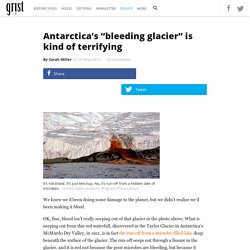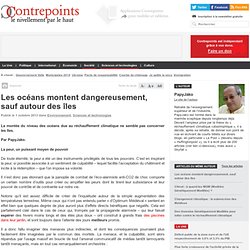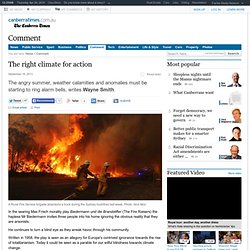

L’Alaska balayé par une canicule exceptionnelle "Bomb cyclone", ce phénomène météorologique qui va bientôt s'abattre sur les Etats-Unis. Les États-Unis affrontent un hiver sévère depuis une dizaine de jours, et la situation ne semble pas près de s’améliorer alors qu’un phénomène connu sous le nom de "bomb cyclone", ou "bombe météorologique" en français, s’approche de la côte Est.

"Bomb cyclone", c’est l’appellation donnée à la tempête menaçante qui est attendue sur la côte Est pour aujourd'hui. Tandis que le Canada range ses manchots à l’abri du grand froid, les États-Unis traversent également un hiver particulièrement rude. D’après CNN, 90% du pays a passé le Nouvel An en-dessous de 0°C. Et malheureusement pour la côte Est, tout semble indiquer que la situation n’est pas près de s’améliorer. En effet, une tempête de neige et de glace géante arrive actuellement de l’Atlantique pour frapper le littoral depuis l’état de Géorgie jusqu’au Maine.
Les spécialistes donnent à ce phénomène le nom de "bomb cyclone", ou tout simplement "bombe météorologique" en français. Formation d’une bombe. Meet July, the hottest month yet. Our planet has never been warmer than it was last month, according to data released by NASA on Tuesday.

Yes, you’ve heard some version of that story before, and you’re sure to hear it again and again in the coming years, but this time, it’s a bit freaky. The news that July was the hottest month on record comes as a relative surprise, because there hasn’t even been an El Niño this year — the natural climate shift that usually boosts global temperatures. In fact, 2017 started with La Niña conditions, which tend to temporarily cool the planet, yet we still wound up with a record anyway. That’s shocking, as well as compelling evidence that anthropogenic climate change is picking up speed. 2016 s’inscrit comme « une année noire pour le climat » 2016, « une année noire pour le climat » : c’est le constat qu’ont fait les quelque 500 scientifiques, venus de plus de 60 pays, dans le rapport annuel sur « l’Etat du climat », qui compte près de 280 pages.

L’année 2016 aura atteint de bien tristes records. Le dernier rapport informant sur « l’Etat du climat », publié par l’Agence américaine océanique et atmosphérique (NOAA) ainsi que l’American Meteorological Society (AMS), dresse un sombre bilan de l’année passée, durant laquelle les spécialistes ont constaté une forte hausse des températures, une montée inquiétante des eaux océaniques et une augmentation considérable des émissions de gaz à effets de serre. De fortes chaleurs ont fondu sur de nombreux pays au cours de l’année 2016, comme notamment en Inde, au Mexique et même la France. Des records battus sur tous les plans climatiques D’autres marqueurs importants ont permis de confirmer le net réchauffement de la planète. Spring just keeps getting earlier. Guess what’s behind it? In some parts of the country, the season just breezed in three weeks ahead of schedule.

Balmy weather may seem like more good news after an already unseasonably warm winter, but pause a beat before you reach for your flip-flops. According to the “spring index,” a long-term data set which tracks the start of the season from year-to-year, spring is showing up earlier and earlier across the United States. The culprit behind the trend? Climate change. Focus sur les étés extrêmes. L'été météorologique, qui commence le 1er juin et s'achève à la fin du mois d'août, correspond à la période la plus chaude de l'année dans l'hémisphère Nord.

En moyenne, sur l'Hexagone, la température normale* de la saison est de 19,9°C. Petit tour d'horizon des étés records en matière de température : Antarctica’s “bleeding glacier” is kind of terrifying. We knew we’d been doing some damage to the planet, but we didn’t realize we’d been making it bleed.

OK, fine, blood isn’t really seeping out of that glacier in the photo above. What is seeping out from this red waterfall, discovered in the Taylor Glacier in Antarctica’s McMurdo Dry Valley, in 1911, is in fact the run-off from a microbe-filled lake deep beneath the surface of the glacier. The run-off seeps out through a fissure in the glacier, and it is red not because the poor microbes are bleeding, but because it comes from a very iron-rich environment. Les océans montent dangereusement, sauf autour des îles. La montée du niveau des océans due au réchauffement climatique ne semble pas concerner les îles.

Par PapyJako.La peur, un puissant moyen de pouvoir De toute éternité, la peur a été un des instruments privilégiés de tous les pouvoirs. C’est en inspirant la peur, si possible associée à un sentiment de culpabilité – lequel facilite l’acceptation du châtiment et incite à la rédemption – que l’on impose sa volonté. Did Climate Change Worsen the Colorado Floods? Last Thursday, as torrential rains turned into floods that washed away homes, roads, and bridges in Boulder, Colorado, and the surrounding region, the local National Weather Service forecast office went ahead and said what we were all thinking.

It put it like this: The word "biblical" certainly captures the almost preternatural scale of the Colorado floods, and the rainfall that caused them. Indeed, according to climate scientist Martin Hoerling of the National Oceanic and Atmospheric Administration, "this single event has now made the calendar year (2013) the single wettest year on record for Boulder.
" But does that mean that climate change is involved? Although suggestive, broken records alone do not constitute definitive proof that humanity's fingerprints have been left on a particular weather disaster. The right climate for action. A Rural Fire Service brigade abandons a truck during the Sydney bushfires last week.

Photo: Nick Moir In the searing Max Frisch morality play Biedermann und die Brandstifter (The Fire Raisers) the hapless Mr Biedermann invites three people into his home ignoring the obvious reality that they are arsonists. He continues to turn a blind eye as they wreak havoc through his community. L'impressionnante fracture d'un glacier filmée par des chercheurs au Groenland. En 2010, deux scientifiques en mission au Groenland ont assisté à l’effondrement d’un pan de glace provenant du glacier Helheim.

Alors qu’ils étaient en expédition en juillet 2010, Timothy James et Nick Selmes, ont assisté à un spectacle étonnant : l’effondrement d’un énorme pan d’un glacier. California Gov. Jerry Brown blames climate change for early wildfires. Does early snow disprove global warming? During the run-up to Wednesday’s debate, I remember seeing kids in the background of live shots wearing shorts and thinking, “Huh. Looks pretty nice in Denver.” Friday morning, it snowed there. It snowed this week in Minnesota and North Dakota, too, in some places, more than a foot deep. Where did all the tornadoes go? The drought that parched much of the nation during the past year didn’t just stunt crops — it also stunted the annual yield of tornadoes.
And an unseasonably chilly spring is so far helping to keep the hellish twisters at bay — although weather forecasters warn that trend may be short-lived. During the past 12 months, the U.S. was hit by an estimated 197 tornadoes rated EF1 or stronger on the Enhanced Fujita scale, which ranks tornadoes according to their destructive potential from a low “0″ up to a devastating “5.”
That was the lowest number of such tornadoes during any 12-month period since record-keeping began in 1954 — well below the previous low of 247 recorded between July 1990 and June 1991. That’s in huge contrast to the onslaught of tornadoes that tore deadly paths of destruction through the nation in 2011, which was a record-busting year of tornadoes galore. These tornado statistics come from NOAA National Severe Storms Laboratory researcher Harold Brooks. Weird wintry weather and the climate-change link. It was high time to pass around a few cold ones in the shade of an awning in Amarillo, Texas, just a few days ago. Now it’s time to hunker inside, drink whiskey neat, and play charades. The city broke a heat record on April 30, reaching a scorching hot 97 degrees. Then it got hit by unseasonably cold weather that has swept through the nation’s heartland. A couple days after reaching 97, the temperature bottomed out at 33 degrees, with the cold snap bringing some snow.
Opinion: Record snow in a warming world? The science is clear. Snow blankets Boston on Friday, Feb. 8, 2013. Heavier winter storms fit a pattern predicted by climate scientists as the world warms. Photo by Christopher Petroff/flickr. Feb. 9, 2012. "Global warming" hits Germany: Coldest and snowiest day in decades. Vidéo : une tornade au Portugal fait une vingtaine de blessés. Ces trois derniers jours, le Portugal a été balayé par une vague de mauvais temps qui a fait de sérieux dégâts dans le pays. Une tornade s'est même formée vendredi et a blessé une vingtaine de personnes. Video - La tornade de Toulouse filmée par les internautes. Video - Le déplacement et la fonte du glacier du Bionnassay en images - Maxisciences. A raison de six photos par jour capturée au niveau du glacier du Bionnassay, dans le massif du Mont-Blanc pendant 2 ans et demi, on se rend bien compte de sa vitesse de déplacement.
46 Square Miles Of Iceberg Break Off In Greenland (Video) A huge iceberg that’s about twice the size of Manhattan has torn off the Petermann Glacier in Greenland, illustrating another dramatic change to the warming island. For several years, scientists had been watching a long crack near the tip of the northerly Petermann Glacier. On Monday, July 16, NASA satellites showed it had broken completely, freeing an iceberg measuring 46 square miles.
About four-fifths of Greenland is covered by a massive ice sheet; Petermann Glacier is mostly on land, but a segment sticks out over water, and that’s where the break occurred. From NPR: Un iceberg gros comme New York est en train de se détacher de l’Antarctique. La canicule, un signe du réchauffement climatique. Météorologues et climatologues sont d'accord: la canicule qui vient de frapper la France ne constitue pas une preuve du réchauffement climatique, mais la multiplication et la sévérité de ces vagues de chaleur sont un signe clair de l'évolution du climat sur la planète. «Si on prend l'événement en lui-même, on ne peut pas l'attribuer à 100% au réchauffement climatique», note le prévisionniste de Météo-France Jérôme Lecou, qui rappelle que «de très forts phénomènes de chaleur ont eu lieu dans le passé», alors que le réchauffement n'avait pas commencé.
«S'il a fait 38,5 degrés le 18 août à Châteauroux (Indre), il y avait fait 40 degrés en 1898», dit-il. Les canicules de plus en plus fréquentes «Au cours des cinquante dernières années, on a pu observer qu'à mesure du réchauffement, les canicules deviennent de plus en plus fréquentes», ajoute-t-il. Pour lui, «si on ne fait rien, on aura des risques dix fois plus élevés de canicule à la fin du XXIème qu'à la fin du XXème». L’été s’allonge. Photos - Un papillon exotique découvert au Québec. Global Warming's Unseen Effects on Plants and Butterflies. Many of the effects of climate change and global warming — such as the recent strangely snowless, mild winter on the East Coast — are too apparent. New research in the Proceedings of the Natural Academy of Sciences (PNAS) entitled “Divergent responses to spring and winter warming drive community level flowering trends” shows that wild plant species previously thought to be “stable” and to be unaffected by climate change are actually responding to it.
Researchers from the University of California at Santa Barbara’s National Center for Ecological Analysis and Synthesis (NCEAS) found that wild plants that had been thought to be resilient to the past 20 to 50 years’ warming trends because they did not bloom earlier were “actually responding to climate temperature change in a manner that is not as easily seen as in plants that exhibit earlier flowering in response to an advanced spring.”
These plants have been responding to warmer winters by delaying flowering. Record Heat Wave Sweeps Across U.S. If you look at any meteorology map these days, you’ll notice a lot more pink and red (indicating high temperatures) than you’re probably accustomed to. Sure, it’s summer and it gets hot, but it’s only the beginning of July, and we still have the majority of the hottest weeks to go. Over the past week particularly, temperatures have soared, breaking records in numerous cities and states. Mid-Atlantic residents are still recovering from a rare “derecho” storm that caused numerous high-powered thunderstorms and massive power outages across the region.
Must-See: Best News Report This Year On Link Between Climate Change And Extreme Weather. By Joe Romm "Must-See: Best News Report This Year On Link Between Climate Change And Extreme Weather" Last week I wrote that “Every Network Gets Extreme Weather Story Right.” Spring 2012 Likely To Be The Hottest Ever. The spring of 2012 is due to be the hottest in 117 years, since 1895. Considering this past winter was the fourth-hottest on record (with an average temperature of 42 degrees Fahrenheit in the contiguous US states), March simply the hottest and April the third-hottest, that may come as no surprise.
Tree Death Rates Double In Old-Growth Forests. Regional warming is likely to blame for a steady increase in tree death rates in old-growth forests of the western United States, according to 2009 study in Science. The study, led by the U.S. Geological Survey (USGS), found that the increase in dying trees has been pervasive. Tree death rates have increased across a wide variety of forest types, at all elevations, in trees of all sizes and in pines, firs, hemlocks and other kinds of trees. Angleterre : grande sécheresse déclarée. L’été semble encore loin, pourtant, en Grande-Bretagne, les habitants doivent déjà restreindre leur consommation d’eau. Le manque de pluies provoque une importante sécheresse, pire qu’en 1976, et l’arrivée des beaux jours ne va pas arranger les choses.
La situation au mois de février est pire qu'en 1976, année de la plus grande sécheresse au Royaume-Uni. Nappes phréatiques quasi sèches, en plein mois de février, les agriculteurs et éleveurs britanniques paniquent et ils ne sont pas les seuls. Les précipitations moyennes de cet hiver en Grande-Bretagne ont été plus faibles qu’en 1976, année de la plus grave sécheresse au pays. Elle avait alors provoqué la perte de nombreuses récoltes, des incendies et des coupures dans l’approvisionnement d’eau. . « L’été dernier a été très sec, mais cette année s’annonce encore bien pire puisque l’hiver n’a pas apporté les pluies que nous espérions.
Les zones les plus touchées sont l’Est de l’Angleterre, les Midlands et le Sud-Est. Une sécheresse exceptionnelle frappe l'Europe. Sécheresse : 80% des nappes phréatiques ont un niveau «inférieur à la normale» Did climate change cause the epic Great Plains drought? Desertification crisis affecting 168 countries worldwide, study shows.
Drought: What happens when Asia's 'water tower' dries up? Flood-drought-flood: Is this the new normal? Colorado fire: Is global warming one of the culprits? (+video) Mexique: le gel et la sécheresse menacent de provoquer une famine.